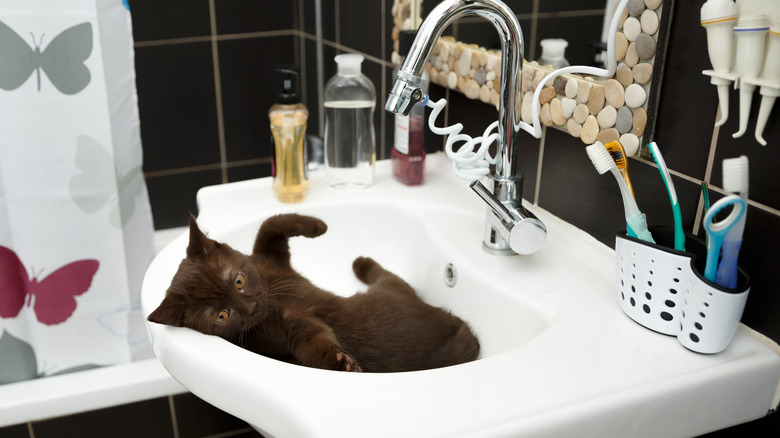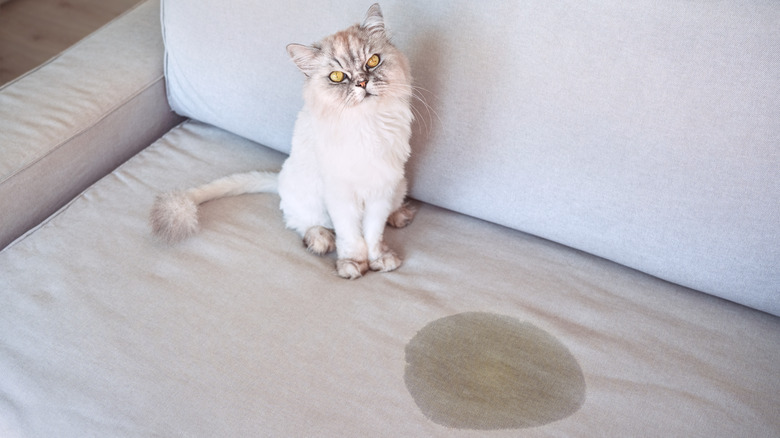The Common Hygiene Brand That Can Remove Cat Odors
Accidents happen. Whether it's a new kitten still learning the rules or an older feline having an off day, dealing with cat urine can be an unexpected challenge. The worst part? You might not always have a specialty cleaner on hand to tackle the mess. That's where this clever trick comes into play: You can neutralize stubborn cat odors quickly and effectively using Listerine, something many households already have in their medicine cabinets.
Best known for freshening breath and fighting mouth germs, Listerine contains ingredients that make it surprisingly effective against pet odors. It's not the brand itself that works the magic; it's the active components like essential oils and alcohol that can come to your rescue, and they may also be found in other household products. Similar to using baking soda and peroxide to get rid of pet urine odors, these antibacterial elements target the root cause of bad smells, offering a simple and practical alternative to enzyme cleaners and other specialized solutions. For these reasons and more, Listerine might just be your next go-to for a fresher home.
The science behind using Listerine as an odor remover
Since we use mouthwashes like Listerine to combat bad breath, it's reasonable that they're effective at neutralizing odors beyond our jowls. After all, the active ingredients — essential oils like thymol, menthol, and eucalyptol, as well as alcohol — possess antimicrobial properties that combat odor-causing bacteria. While it may reek of associative thinking gone feral as we're scrambling to clean cat pee out of the carpet, this home hack is grounded in the domestic rigors of science.
Essential oils like thymol and eucalyptol are known for their ability to disrupt bacterial membranes. Research on essential oil efficacy, such as a 2013 study published in the Journal of Pharmaceuticals, explains that these compounds penetrate bacterial cells, which ultimately leads to cell death. This effectively neutralizes odors at their source rather than merely masking them.
The alcohol content in Listerine plays a pivotal role as a solvent and antimicrobial agent. Alcohol helps break down certain compounds, including some odor-causers, while facilitating the removal of residues. This breakdown of urine can also prevent spraying in the same spot. Additionally, alcohol enhances the penetration of essential oils into bacteria's protective layers, amplifying their antimicrobial efficacy. While alcohol aids in dispersing odors temporarily, urine components like ammonia and thiols may require additional chemical reactions or agents for complete neutralization.
How to employ the Listerine trick safely
To use this hack, start by diluting one part Listerine with three parts water in a spray bottle. Spray the solution directly onto the affected area, ensuring enough coverage to penetrate the surface without over-saturating, which could lead to material damage. Let the solution sit for five to 10 minutes, giving the active ingredients time to neutralize bacteria and break down odor-causing compounds. Finally, rinse the area thoroughly with water, and dry it completely with a clean cloth or towel to prevent any residue from lingering.
Safety precautions are essential when using this method. Cats are sensitive to the smells of essential oils and are repelled by them, which is useful when deterring them from areas. However, when treating surfaces with these ingredients, it's imperative to thoroughly rinse the area to prevent accidental exposure. Avoid using the solution near areas where cats groom or lick frequently, and always test it on a small, inconspicuous area first to ensure it doesn't cause discoloration or damage. By following these steps and precautions, Listerine, and similar products, can provide a convenient and effective way to manage cat odors.

